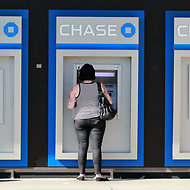The SP 500 has risen for five of the past six weeks, gaining more than 7 percent over that period. The index closed at an all-time high on Friday despite a disappointing read on the labor market, which showed that hiring slowed in July.
Given that advance, further gains may be difficult to come by at these levels, especially with the corporate earnings season largely over.
In the latest read on the services sector, the Institute for Supply Management’s July non-manufacturing index came in at 56, above expectations of 53 and over the previous month’s read of 52.2. Stocks were little impacted by the data.
“Growth continues to be anemic, even as we’re at record levels in the market, suggesting we’re overbought on some levels,” said Mark Martiak, senior wealth strategist at Premier/First Allied Securities in New York.
While the recent payroll report was weaker than expected, some investors were encouraged that it meant the U.S. Federal Reserve was more likely to hold steady with its monetary stimulus, which has contributed to the SP’s gain of almost 20 percent this year.
Tyson Foods rose 3.5 percent to $29.50 before the bell after giving a full-year revenue outlook that was above expectations.
The Dow Jones industrial average was down 54.26 points, or 0.35 percent, at 15,604.10. The Standard Poor’s 500 Index was down 3.43 points, or 0.20 percent, at 1,706.24. The Nasdaq Composite Index was down 1.90 points, or 0.05 percent, at 3,687.69.
The SP 500 is about 1 percent above its 50-day moving average of 1,690.57, which could serve as a support level against further losses.
In the Nasdaq, losses were limited by Priceline.com Inc, which rose 1.6 percent to $922.73 after JPMorgan raised its price target on the stock from $830 to $1,040.
Qualcomm Inc fell 1.5 percent after Piper Jaffray downgraded the stock to “neutral” from “overweight.”
U.S. shares of HSBC Holdings Plc fell 5.3 percent to $54.90 after the company reported a drop in revenue, hurt by slower emerging markets.
Of the 391 companies in the SP 500 that have reported earnings for the second quarter, 67.8 percent have topped analyst expectations, in line with the average beat over the past four quarters, data from Thomson Reuters showed. About 55 percent have reported revenue above estimates, more than in the past four quarters but below the historical average.
In other company news, U.S.-listed shares of Compugen Ltd jumped 49 percent to $8.15 after the company announced it would enter a cancer research partnership with Bayer AG.
The New York Times Co agreed to sell The Boston Globe for $70 million in cash, less than a tenth of what the media company paid when it bought the newspaper for $1.1 billion in 1993. Shares dipped 0.4 percent to $11.88.
Analysts said that millions of Time Warner Cable subscribers in New York, Los Angeles and Dallas could be without CBS Corp programming for several weeks as the companies appear no closer to settling a fee dispute.
Shares of Time Warner Cable rose 0.6 percent to $117.78 while CBS was flat at $54.55.
(Editing by W Simon and Nick Zieminski)

Article source: http://www.nytimes.com/reuters/2013/08/05/business/05reuters-markets-stocks.html?partner=rss&emc=rss
